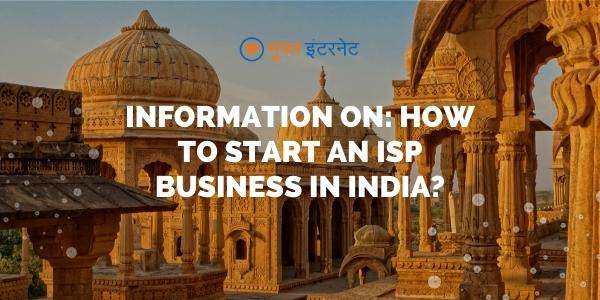10 Steps To Start Your Own ISP Business In India
Do you want to start an ISP in India? Are you looking for a step-by-step guide on how to start your own ISP business in India? Well, you are at the right place!
Introduction: Steps to Start Your Own ISP Business in India
There are a number of steps you need to take in order to start your own ISP business in India. Below we outline the key steps you need to take:
1. Register your business: In order to start an ISP business in India, you first need to register your company with the Registrar of Companies (ROC). This can be done online through the Ministry of Corporate Affairs website.
2. Obtain a license: Once your company is registered, you then need to obtain an Internet Service Provider License from the Department of Telecommunications (DoT). This process can take up to six months.
3. Set up infrastructure: You will need to set up the necessary infrastructure for your ISP franchise in India, which includes obtaining internet bandwidth, setting up servers and routers, and establishing connectivity with other ISPs.
4. Launch your service: Once everything is set up, you can launch your ISP service! Make sure to promote your business and attract customers.
1. Find Funding
If you are planning to start your own Internet Service Provider (ISP) business in India, one of the first things you need to do is find funding. Here are some tips on how to find funding for your ISP business:
1. Look for investors who are interested in the telecommunications industry. There are many venture capitalists and private equity firms that invest in the telecommunications sector. You can try approaching them for funding.
2. Another option is to take out a loan from a bank. Many banks offer loans specifically for businesses in the telecommunications industry.
3. You can also look for government grants or subsidies that are available for starting an ISP business in India. The Indian government provides various subsidies and incentives for businesses that promote broadband penetration in the country.
4. Finally, you can also consider self-funding your ISP business by investing your own personal savings or taking out a personal loan. This option may be riskier but it can also be more rewarding if your business is successful.
2. Find a Location
Assuming that you have made up your mind to start your own internet franchise in India, the first step would be to find a location for setting up your office. This is important because your office should be situated in an area where there is a good demand for internet connectivity. Once you have zeroed in on a suitable location, the next step would be to obtain all the necessary licenses and permits from the local authorities. Only after these formalities have been completed, can you go ahead with setting up your office and starting operations.
3. Register the Company
In order to start your own ISP business in India, you will need to register the company with the Registrar of Companies (ROC). This can be done online or offline. The process is relatively simple and straightforward, and once the company is registered, you will be able to obtain a Certificate of Incorporation.
Once the company is registered, you will need to obtain a license from the Telecom Regulatory Authority of India (TRAI). This license will allow you to provide broadband services in India. The process for obtaining this license is also relatively simple and straightforward.
Once you have registered the company and obtained the necessary licenses, you will need to set up infrastructure for your business. This includes setting up servers, routers, and other networking equipment. You will also need to sign up with an Internet Service Provider (ISP) in order to get connectivity for your business.
After all of this is complete, you will be ready to start providing broadband services to customers in India!
4. Get Licenses and Permits
In order to start your own ISP business in India, you will need to obtain several licenses and permits from the Indian government. Here is a rundown of the licenses and permits you will need:
1. Telecom Service Provider License: This license is required for any company that wants to provide telecom services in India. The application process for this license can be found on the website of the Telecom Regulatory Authority of India (TRAI).
2. Internet Service Provider License: This license is required for any company that wants to provide internet services in India. The application process for this license can be found on the website of the Department of Telecommunications (DoT).
3. Radio Frequency Identification Device License: This license is required for any company that wants to use radiofrequency identification devices (RFID) in India. The application process for this license can be found on the website of the Wireless Planning & Coordination Wing (WPC) of DoT.
4. Cable Operator Registration Certificate: This certificate is required for any company that wants to operate a cable television network in India. The application process for this certificate can be found on the website of the Ministry of Information and Broadcasting (MIB).
5. Design a Network Diagram
Designing a network diagram is an important step in starting your own ISP business in India. There are many software programs that can help you create a network diagram, but it is important to understand the basics of networking before you start. The following steps will help you design a simple network diagram for your ISP business:
1. Decide on the purpose of your network diagram. Are you trying to map out the physical layout of your network? Or are you trying to show the logical flow of data between devices?
2. Choose a software program that suits your needs. If you’re not sure which program to use, consult with a professional for advice.
3. Gather information about your network. You’ll need to know things like the number of devices on your network, their IP addresses, and what kinds of connections they use (Ethernet, Wi-Fi, etc.).
4. Begin designing your diagram. Start by adding the devices on your network and then connecting them together using lines or arrows. Be sure to label each device and connection so that others can understand your diagram.
5. Save or print your diagram for future reference. As your network grows, you may need to update your diagram to reflect changes in the physical or logical layout of your network.
6. Install Network Equipment
Assuming you already have the equipment and just need to install it, here are the steps:
1. Find a good location: The first step is to find a good location for your tower or server room. This should be a spot with good coverage and no obstructions.
2. Prepare the equipment: Once you have found a good location, you need to set up the equipment. This includes setting up towers, antennas, and routers.
3. Connect the equipment: Once everything is set up, you need to connect all of the equipment. This includes connecting the router to the modem and connecting all of the cables.
4. Test the connection: Once everything is connected, you need to test the connection to make sure everything is working properly.
7. Install the Hardware for the Wiring System
In order to install the hardware for the wiring system, you will need to obtain the following items:
-Ethernet Cable
-Modem
-Router
-ISP Gateway Device
-Wireless Access Point
-Ethernet Switch
-Network Cabling
Once you have gathered all of the necessary hardware, you will need to connect the modem to the gateway device. Then, connect the gateway device to the router. Next, connect the Ethernet switch to the router. Finally, connect the wireless access point to the Ethernet switch. Once all of these connections have been made, you will be able to start using your new ISP business in India!
8. Install Data Cables and Connectivity Devices
Installing data cables and connectivity devices is a crucial step in starting your own ISP business in India. There are a few things to keep in mind when installing data cables and devices:
1. Make sure you follow all local building codes and regulations. This includes obtaining any necessary permits.
2. Plan the installation of your data cables and devices carefully. This will save you time and money in the long run.
3. Use high-quality data cables and devices. This will ensure optimal performance of your network.
4. Hire a professional installer if you are not confident in your abilities to do it yourself. This will ensure the job is done right the first time.
9. Connect to the Internet Service Provider
In order to start your own ISP business in India, you will need to connect to an Internet Service Provider (ISP). There are a few different ways to do this, but the most common is to use a broadband connection. This type of connection will allow you to connect to the Internet at high speeds, making it ideal for streaming video and downloading files.
Once you have connected to an ISP, you will need to select a ISP business plan in India that suits your needs. There are many different types of plans available, so make sure to do your research before selecting one. Once you have selected a plan, you will be able to start using the Internet immediately.
If you have doubts and need help in starting your own ISP franchise or business – talk to us. Our network of ISP consultants can help you start your own ISP business, apply for an ISP license or buy bandwidth for resale – Muft Internet’s network of ISP consultants can help you.
ALSO, YOU CAN READ OUR NEW UPDATES
- How to become a WISP in India? Starting a Wireless / Wired Internet Service Provider business
- How to start an ISP business in India with less than ₹ 500,000?
- 8 Steps: How to start an ISP business in India?
- When to start an ISP business in India? Opportunities & Hurdles
- Time to become an ISP! Even after Jio, 60% of India still offline.


